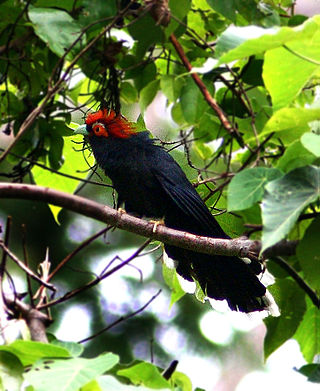Top Qs
Timeline
Chat
Perspective
Rough-crested malkoha
Species of bird From Wikipedia, the free encyclopedia
Remove ads
The rough-crested malkoha (Dasylophus superciliosus) is a species of cuckoo in the family Cuculidae. It is endemic to Luzon Island in the Philippines. Its natural habitat is tropical moist lowland forest. It is declining due to habitat loss and hunting.
Remove ads
Description and taxonomy
It is large, with a long tail and a unique crest. It is sexually monomorphic.[2] Its upperparts, wings, and tail are black with bluish green gloss. Its superciliary, or eyebrow, is composed of long, loosely-webbed red feathers running from its lores to its nape. Its graduated tail feathers are tipped white, and its underparts are black with a dull greenish tinge.

Subspecies
Two subspecies are recognized
Remove ads
Ecology and behavior
It feeds on insects, especially favouring caterpillars and small mammals, reptiles and amphibians. Forages in the lower levels and likes climbing vines and tangles. Usually observed alone or in small groups. Not much information on breeding data but believed to breed from May to June. A nest was found to have 3 eggs but not enough data to assume clutch size. [4]
Habitat and conservation status
Its natural habitats are tropical moist lowland forest up to 800 meters above sea level. The IUCN has classified the species as least Concern where it is said to be locally common. However, the population is believed to be declining due to deforestation from land conversion, Illegal logging and slash-and-burn farming.
It is found in multiple protected areas such as Mount Banahaw, Mount Makiling, Mount Isarog, Bataan National Park and Northern Sierra Madre Natural Park but like all areas in the Philippines, protection is lax and deforestation and hunting continues despite this protection on paper.[1]
References
Wikiwand - on
Seamless Wikipedia browsing. On steroids.
Remove ads


